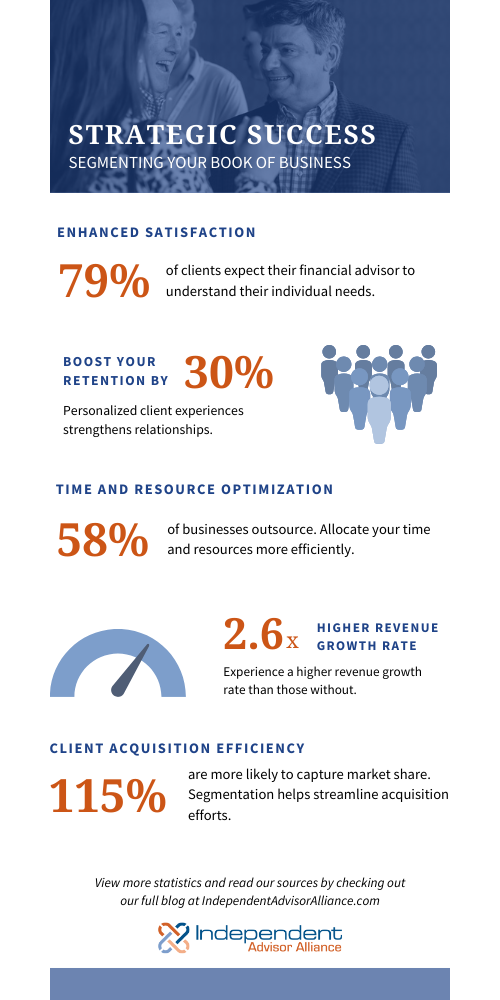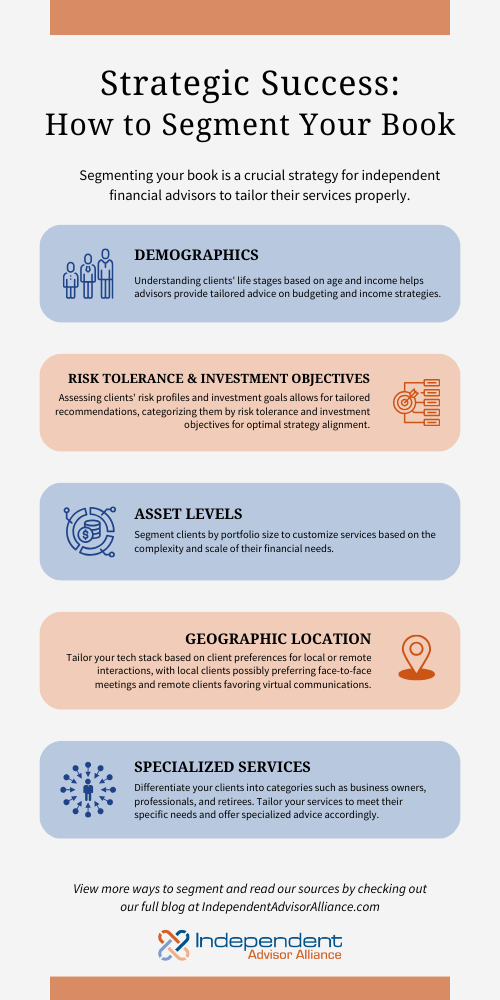In the intricate world of financial advisory services, where client needs and financial goals vary widely, adopting a one-size-fits-all approach is no longer a sustainable strategy. Enter the art and science of segmenting a financial advisor’s book of business. Why is it so crucial? The answer lies in the ability to deliver tailored, personalized services that resonate with each client’s unique circumstances.
As the financial landscape evolves and client expectations continue to rise, segmentation has emerged as a strategic imperative for advisors aiming to match services to client needs. In this post, we will explore the compelling reasons why financial advisors should embrace segmentation and delve into actionable insights on how to effectively implement this strategy, ensuring that each client receives the specialized attention they deserve.
Why You Should Segment Your Book
Statistics on the Importance of Segmenting a Financial Advisor’s Book of Business:
1. Enhanced Client Satisfaction
Advisors should know their clients. 79% of clients expect their financial advisor to understand their individual needs1. Segmenting allows advisors to tailor services, leading to higher client satisfaction.
2. Improved Client Retention
Personalized client experiences can boost retention rates by up to 30%2. Effective segmentation enables advisors to deliver personalized financial solutions, strengthening client relationships.
3. Targeted Marketing Impact
Targeted marketing campaigns are 36% more effective3. Segmenting your book of business enables precise targeting, increasing the impact of marketing efforts.

4. Time and Resource Optimization
Don’t go at it alone. 58% of businesses outsource to optimize resources4. Segmenting allows financial advisors to allocate time and resources more efficiently, focusing on high-priority clients.
5. Revenue Growth Potential
Companies with effective segmentation strategies experience a revenue growth rate 2.6 times higher than those without5. Applying segmentation in financial advisory can unlock growth opportunities.
6. Adaptability to Market Changes
Segmentation can improve how advisors respond to the market. 89% of businesses using segmentation can quickly adapt to market changes6. Financial advisors, through effective segmentation, can stay agile and responsive to evolving market dynamics.
7. Risk Mitigation
Risk is a reality but it can be mitigated. 56% of companies outsource to manage risks7. Segmenting clients based on risk profiles allows advisors to implement targeted risk management strategies, reducing overall business risk.
8. Client Acquisition Efficiency
The Harvard Business Review suggests that organizations utilizing customer segmentation are 115% more likely to capture market share8. Efficient client segmentation streamlines client acquisition efforts for financial advisors.
9. Increased Cross-Selling Success
Consumers, including investors, expect a personalized experience. A report indicates that 79% of customers are more likely to buy additional products when their experience is personalized9. Segmenting facilitates personalized cross-selling strategies, boosting success rates.
10. Digital Engagement Advantage
A survey by McKinsey highlights that companies using personalization extensively can achieve digital revenue increases of 10% or more10. Segmenting enables personalized digital engagement strategies for financial advisors.
How to Segment Your Book
Segmenting a book of business is a crucial strategy for independent financial advisors (IFAs) to tailor their services effectively, prioritize clients, and allocate resources efficiently. Here are various methods for IFAs to segment their books of business:

1. Demographic Segmentation:
- Age Group: Categorize clients based on age brackets (e.g., millennials, Gen X, baby boomers) to address specific financial needs related to life stages.
- Income Levels: Segment clients by income to provide tailored advice on budgeting, investment strategies, and wealth management.
2. Life Stage Segmentation:
- Family Status: Consider the family structure, such as singles, couples, or families with children, to address unique financial goals and challenges.
- Retirement Status: Segregate clients based on their retirement stage to provide personalized retirement planning and income strategies.
3. Risk Tolerance and Investment Objectives:
- Risk Profiles: Assess clients’ risk tolerance and categorize them into conservative, moderate, or aggressive investors, tailoring investment recommendations accordingly.
- Investment Goals: Segment clients based on their specific investment objectives, such as capital preservation, income generation, or capital appreciation.
4. Asset Levels:
- Portfolio Size: Segment clients by the size of their investment portfolios to customize services based on the complexity and scale of their financial needs.
- High Net Worth vs. Mass Affluent: Distinguish between high-net-worth clients and mass affluent clients to provide specialized services and investment strategies.
5. Communication Preferences:
- Digital vs. Traditional: Segment clients based on their preferred communication channels, whether it’s digital (email, online platforms) or traditional (phone calls, in-person meetings).
- Frequency of Communication: Tailor communication frequency based on individual preferences, ensuring clients receive information in a manner that suits their needs.
6. Geographic Location:
- Local vs. Remote: Consider whether clients are local or remote and tailor services accordingly. Local clients may benefit from in-person meetings, while remote clients may prefer virtual communication.
7. Specialized Services:
- Business Owners vs. Professionals: Segment clients based on their occupation, distinguishing between business owners, professionals, or retirees, and offering specialized services related to their unique financial situations.
- Specialized Financial Needs: Identify clients with specific financial needs, such as estate planning, tax optimization, or education funding, and provide targeted advice accordingly.
8. Client Engagement and Loyalty:
- Client Tenure: Segment clients based on the duration of the relationship to identify long-term clients for special recognition and loyalty programs.
- Engagement Level: Assess client engagement and segment based on the level of interaction, allowing IFAs to allocate resources more effectively.
By adopting these segmentation methods, independent financial advisors can tailor their services, deepen client relationships, and enhance overall client satisfaction.
- KPMG. “Global Advisor Pulse Survey.” ↩︎
- EY. “The Future of Wealth Management.” ↩︎
- HubSpot. “The State of Marketing Strategy Report.” ↩︎
- Deloitte. “2018 Global Outsourcing Survey.” ↩︎
- McKinsey. “The Power of Personalization – and how to get it right.” ↩︎
- Accenture. “The Rise of Generation C.” ↩︎
- PwC. “The Hidden Value of Complying with Contractual Obligations.” ↩︎
- Harvard Business Review. “How to Segment Your Market.” ↩︎
- Salesforce. “State of the Connected Customer.” ↩︎
- McKinsey. “Personalization at Scale.” ↩︎

